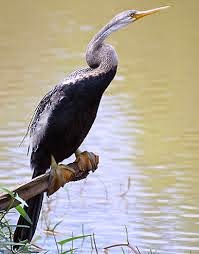Cockatoo king or the scientific name is a kind of bird Probosciger aterrimus black cockatoos and large, with a length of about 60cm. This bird has a red cheek skin and large black-colored beak. There is a large crest on its head that can be enforced. Females are similar to males.
Cockatoo king is the only bird in a single clan Probosciger. Regional distribution of this bird is on the island of New Guinea and northern Australia. King Parrot bird feed consisting of grains. Parrot beak king can not be closed, due to the size of half of the top and bottom are different. And it's useful to hold and open the grain to be consumed.
Although the species is threatened by habitat loss and poaching of forest continued to trade, cockatoos king still often found in their habitat. King cockatoo evaluated as low risk in the IUCN Red List.
King of The Biggest Black Cockatoos.
Cockatoo king (Probosciger aterrimus) or Black Cockatoo is one of Indonesian parrots. In contrast to other types of cockatoos, king parrots have black fur and black crested anyway. The size is very large, reaching 60 cm, making it the largest cockatoo species in Indonesia.In some areas of King Parrot called by different names. Local names include alkai (Aru), awehie (Membramo), Kasmalas (north-west Papua), Mampais (Doreh), Sangya (Sorong), and Siong (I wish). Whereas in English parrots is named Palm Cockatoo, Cockatoo Cape York, the Great Palm Cockatoo, Black Macaw, Great Black Cockatoo, Cockatoo or Goliath.
Latin name of the family pet is Probosciger aterrimus Cacatuidae (Gmelin, 1788), the name synonymous Probosciger aterrinus (Gmelin, 1788). There are four subspecies of king parrots that P.A. aterrimus, P.A. goliath, P.A. stenolophus, and P.A. macgillivrayi.
King Parrot descriptions and characteristics.
King-sized cockatoo with a body length between 51-64 cm reach. Black body feathers, colored crested black, and red cheeks. Crested this can be enforced. The size of a very large and long half-life (half females are smaller) are colored black. The tongue is red with a black tip. While the colors on dark eye circles, dark brown eyes and gray legs.In addition to black fur, typical is the current king parrots fly, feather crest held high (standing upright). King parrots sound when calling a loud squeal like sound keeyaank !, eeyohn! or raah !. Also the sound of whistling uree uree uree yurrr rhythmically.
Live alone or in small groups of up to 5 membered birds. Parrot Bird King (Probosciger aterrimus) are diurnal animals are active during the day. Food is the main grains are large and hard, in addition to eating fruit and leaf buds.
Habitat, Distribution, and Conservation.
King cockatoo bird is native to Indonesia who inhabit almost the entire island of Papua. Also found in the Aru Islands, Misool island (Raja Ampat Islands) and several other small islands. In addition, black parrots live in Australia too and Papua New Guinea.King Parrot bird habitat inhabit lowland tropical rain forest, deciduous forest, secondary forest, forest edge up to the area at an altitude of 1,300 meters above sea level.
Global population has not been established. But still pretty much expected to live in the wild. To subspecies Probosciger aterrimus macgillivrayi predicted to have stable populations add up all 3,000 adult tail. Because of the International Union for the Conservation of Nature in the IUCN Red List just put it as Least Concern species. While the Convention on International Trade in Endangered Species of Wild Fauna and Flora (CITES) Appendix I include it in the list since October 22, 1987.
In Indonesia, the Parrot King is one of the birds that are protected under Government Regulation No. 7 of 1999.
King Parrot Scientific Classification: Kingdom: Animalia. Phylum: Chordata. Class: Aves. Order: Psittaciformes. Family: Cacatuidae. Genus: Probosciger. Species: Probosciger aterrimus. Thank you for reading this article. Written and posted by Bambang Sunarno. sunarnobambang86@gmail.com
author:
http://schema.org/Personal.
https://plus.google.com/105319704331231770941.
name: Bambang Sunarno.
http://faradice.blogspot.com/2014/09/cockatoo-king.html
DatePublished: September 28, 2014 at 15.50
Code : 42S4UXRR3UM
.jpg)




.jpg)







